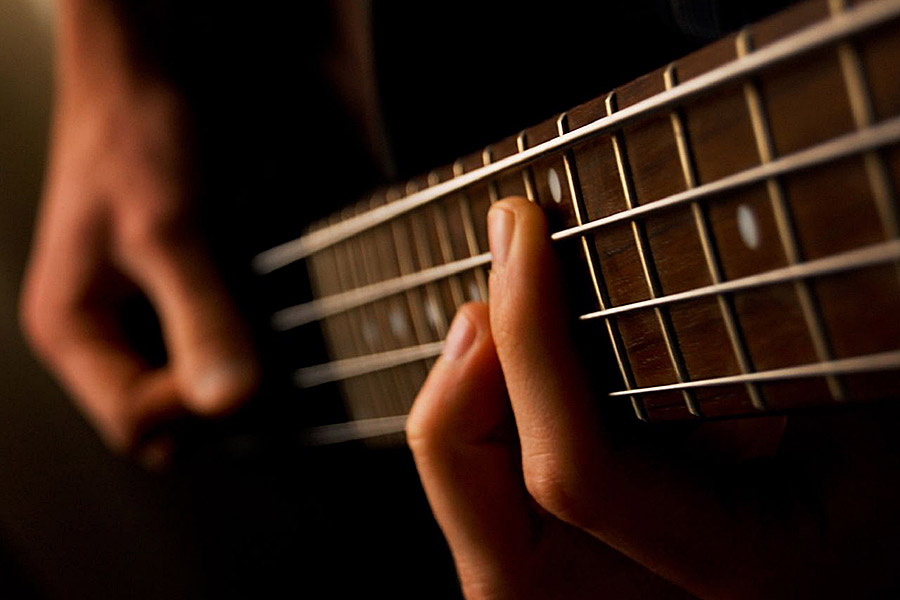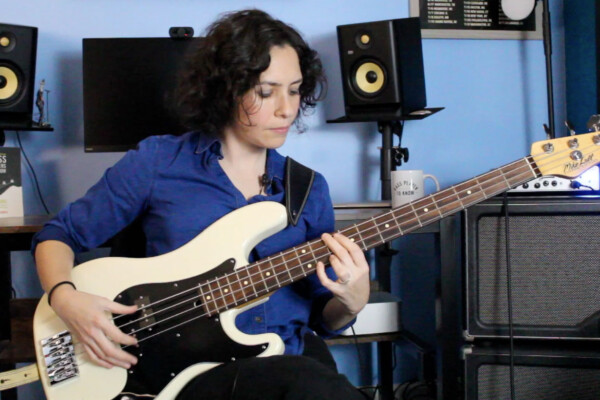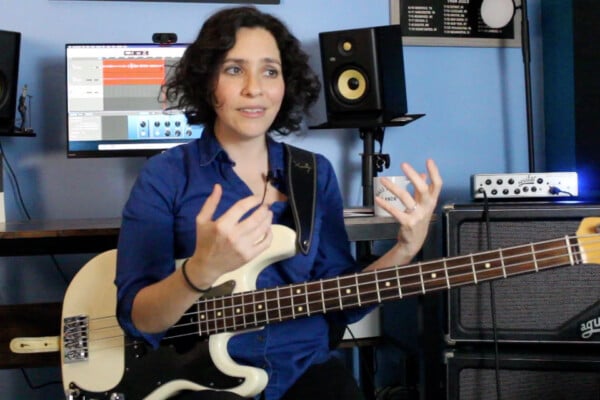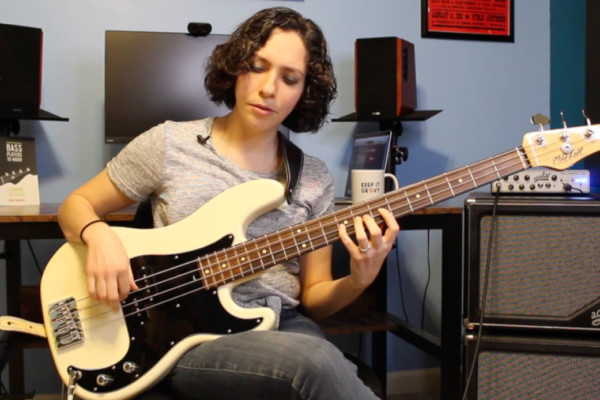Where To Start with Music Theory

Q: My questions is regarding theory. As a bass player of about 7-8 years, in my mid 20’s, I find that not knowing anything about music theory is starting to hinder my progression. When I first started on the bass, I was taught by fellow bandmates how to play the songs we wrote by them telling me where to put my fingers and in what patterns. At gigs, I wouldn’t even know how to tune my bass or what any of the controls did on the bass and would leave it up to the guitarist to give me a tuned and dialed in the bass at the start of the show. I just practiced enough to be able to play the songs easily in a live setting with no knowledge of what and why I was playing it. Up until about a year ago I really didn’t mind the fact of not knowing theory, I saw it as a sort of freedom, even if what I was playing is wrong it didn’t matter because I didn’t know the right way to play if that makes sense. Now its come to the point where I really want to take my playing to the next step and start understanding musical theory. The issue I am experiencing is there is so much information on theory but where do I start? I have no ear for music either, I can’t learn a song by listening to it, being dyslexic I find any prolonged knowledge intake very tough and would have to come away and re-visit hours sometimes days later. My question is: where do I start with theory and how do I start applying it to my playing so I know if someone says “jam in G,” I can start to piece together the right notes and take my playing further? I’m more than happy to put the effort in but knowing where to start is where I struggle. It’s a vast, vast area I’ve not once dabbled in, and being a pretty proficient player the idea of taking it right back to learning super slow is daunting but I’m willing to give it a go! Any guidance you can give me would be fantastic!
A: There are really two ways to approach the learning of making music (there are really more if you parse them out but, in my mind, they basically fall into one of two categories).
1. You study the theory and ‘rules’ of harmony. Scales, modes, functional harmony, arranging, etc., and develop a somewhat mathematical understanding of music. Essentially, you learn what works and why and then learn how to actually make the music feel good by virtue of the time you put in making it.
2. You learn by ear and by doing. You might start in the church or with your friends when young. You just continue to learn tunes by ear, devouring the music you love and learning where every note of it lives on your instrument. You play by feel, sense, and by listening and reacting.
Often, the best of the best have a balance of both approaches.
Personally, I started with the nuts and bolts and then fostered the ear and more intuition-based side of making music later in life.
Most of the dyslexic, musician friends I have fall firmly in the ‘play by ear’ category. Some of the better players have also developed a firm understanding of harmony along the way but got there from a place of understanding the sound of things more than the theoretical analyzations on paper, etc., at least initially.
As far as I understand it, being dyslexic can inhibit your ability to sight read music but doesn’t affect your ability to retain knowledge, learned lines, etc. It just means that you may have an easier time working with the sound of things rather than the written word.
Regardless, it sounds like you need to start near the beginning but it really doesn’t have to hurt too much. With most of my beginning students, I have them begin to learn bass lines from the music they love (by ear). I want them to seek out the root motion and figure out where the notes are on the instrument, then explore the best way to play it, focusing on musicality and really copping the vibe of the original part.
The more music you learn, the more of a reference point you will have for how to develop your own lines. Every bass line you learn is a lesson in bass line creation! Personally, I used to pay attention to how the notes related to the key of the song (often looking at the major scale and comparing the pattern I was playing against the patterns of the scale, trying to recognize the tonality within the bass line.
That way, when someone says “Jam in G”, you can use some of those scalar references and shapes from your multitude of lines you’ve already learned. Eventually, you will just be able to hear what’s going on and intuit what will work within it.
With regard to learning lines and worrying about retaining them in your memory. Nobody hears a line once and then has it on lock for the rest of their lives (well, most don’t. Some folks are wired that way, I suppose). Some may have perfect pitch (which can be learned) and may be able to play it as long as they can hear it in their heads but most of us mortals have to play things dozens to hundreds of times before they get etched in the mind. I still forget things I knew like the back of my hand if I don’t revisit them every once in a while.
Everything that you want to do proficiently will require that you do it poorly, often. The only thing too strive for is to suck a little less, each time you do it. Honestly, that’s the secret. Repeated failure, combined with a singular focus on improvement and determination ends in success.
I always suggest (as I’ve done here at No Treble many times) that players think about the player they want to be and compare and contrast that player with who you are in this moment. Now develop a practice plan that attacks each and every one of those areas that require attention if you are to be that player.
I tend to focus on 2, maybe 3, things at once, dividing my practice into chunks that allow me to hone in on my areas of weakness. I take those areas of weakness apart and explore the building blocks of each thing, starting from the beginning, so as to foster a strong foundation and not skip anything unintentionally.
Need to learn your scales? Start with the major scale but really get inside of it and think of every possible way to play it on the fretboard. Take nothing for granted.
Relish starting at the beginning because you are gifting yourself the opportunity to make yourself the best version of yourself that you can, musically speaking. Take your time! There’s no finish line and I promise you that every bit of work you do pays off quickly and everything you learn makes the next thing that much easier to understand and internalize.
Back to your real question of “where do I start”. I say, start at the beginning! Work your ears and learn tunes like crazy. Whatever it is, dig in and figure that stuff out! Set a goal for yourself. A song a week, song a day, album a week.
You want to understand theory? Get a good teacher and start at the beginning. Can you play a major scale? Can you play it over 2 octaves? Can you play it over 2 octaves but playing every other note (1 3 5 7 2 4 6)? Can you break up the pattern and play it in every position on the fretboard? Can you play it on only one string? You get the idea. Start at the beginning but work diligently from there. Then the minor scales. Then modes. Then try things over simple chord changes.
There’s no shame in starting at the beginning. In fact, it’s the only smart thing to do if you’ve skated by without even learning how to tune the instrument. It’s really the only option!
Have a question for Damian Erskine? Send it to [email protected]. Check out Damian’s instructional books, Right Hand Drive and The Improviser’s Path.




The author said it already but learn the key, using a “circle of 5ths”, they have an app. That key are the the notes on the board or the chords that sound good and they essentially make up “the scale”. The scale is a series of patterns of notes that run together over the board all within the key just as a chord is the notes played together. Those notes of the chord are in the scale. 1st, 3rd, and 5th notes make a normal chord. Chord progression uses named chords and a lot are 1st 4th and 5th letter chords in a key. Any major key is in steps to the next appropriate chord or note. A whole step is 2 fret spaces half step is one(except B&E) anyways a lot of people start with the key of C,as it doesnt habe any sharps, which is a half step higher pitch than the regular note or chord.